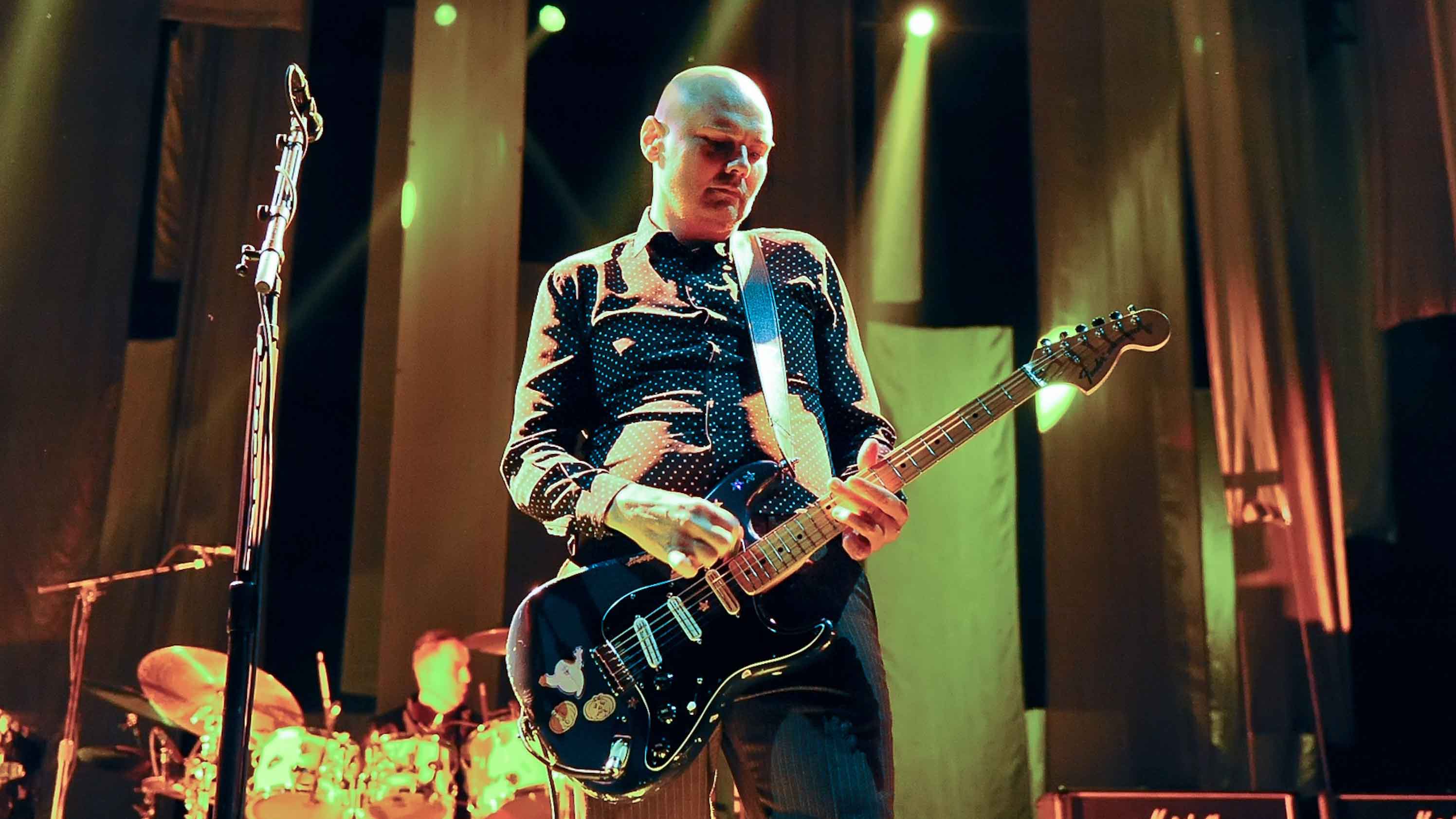Billy Corgan: “The gear should always support your vision”
Guitarist on acoustic solo album Ogilala, his guitar tracking secrets and Smashing Pumpkins reunion

“I didn’t really plan to do another solo album,” confesses Billy Corgan, when asked why this was the year he chose to follow-up 2005’s debut solo outing TheFutureEmbrace.
The Smashing Pumpkins founder is sat inside one of West London’s lavish hotel bars speaking with MusicRadar - enjoying its dimly lit ambience on an unusually sunny autumn afternoon.
He speaks quietly and softly, every bit as thoughtful as you’d expect the writer of songs like Tonight, Tonight and Disarm to be.
Ahead of an industry screening of Pillbox - the new silent movie that accompanies new solo album Ogilala - which is followed by an acoustic set, he takes us into the very heart of the new music…
I never set out to strictly write an acoustic solo album, which is strange because I usually know what I want to do and why I want to do it
“I was actually working on a Pumpkins record and got frustrated, or something. So I quit that and ended up writing a bunch of songs that seemed more like a solo album.
“Then I called Rick Rubin and that’s what led to this - but I never set out to strictly write an acoustic solo album, which is strange because I usually know what I want to do and why I want to do it. I get very fixated on that and this time was the complete opposite! Then the movie came as an afterthought, in the form of a quirky fun tribute to all the silent film I love…”
“And so this time, I just wanted to write songs that I liked,” he shrugs, before pausing to consider his next words, as he often does.
Get the MusicRadar Newsletter
Want all the hottest music and gear news, reviews, deals, features and more, direct to your inbox? Sign up here.
“It sounds strange, but you get used to making music and taking into account what people think - if it makes sense; is it too weird? You account for the audience, you should, that’s normal for any movie or play. At some point, you have to think of who is on the other side. A song shouldn’t be 19 minutes… it should be four, or something.
“But this time, I wrote music that led me in a direction and I just went with it, which was surprising. Whenever I’ve been asked what I was doing when writing specific songs, I can’t actually remember, haha! I was in this particular space, I’d get up in the morning and just work for a while in sort of a dreamlike state.”
Harmonically charged
When it came to the production, Corgan wanted to incorporate more of a 60s organic feel - where multiple instruments seem to create a singular wall of sound, layered in a way that allows them to blend and harmonise indiscriminately…
“I tend to like it like that,” he says.
“That sound of the ’60s when a lot of music was compressed on vinyl. I always loved the Mellotron sound on In The Court Of The Crimson King… it’s in the music, unlike most modern recordings where there’s too much separation.
In the ’60s, sounds mashed together - you couldn’t separate them so easily. It was like an impressionist painting
“In the ’60s, sounds mashed together - you couldn’t separate them so easily. It was like an impressionist painting: is that the guitar or sitar or something else? It’s a bit fuzzy and I like that; there’s a tonal richness.”
That tonal richness he speaks of has long been Smashing Pumpkins’ forte - using warm Les Pauls against brighter Strats - to cover as much of the sonic spectrum in a melee of burning fuzz.
“I’ve always found if you have something with a lot of dense harmonics and put it with something else with dense harmonics, the harmonics will create a different music,” reveals Corgan.
“That was always my application with Pumpkins guitars. If you double-track your guitars super-tight, the harmonics will create a third guitar ringing over the top…
“A lot of people have trouble recreating that sound because you have to play so precisely - and in most cases, I would all do the rhythm tracks and double-track myself!
“What made it harder was getting the same ring, because the attack profile on a Les Paul and Strat are different. Getting them to match wasn’t anywhere as easy as playing the same guitar twice.”
How Rick rolls
Producer Rick Rubin also took a very hands-on role with Ogilala’s 11 tracks - allowing Corgan to retreat more into more of a working musician’s mentality. The collaboration was very much built on freedom and trust, which the singer/songwriter was only too happy to give…
“Think of a song like a sketch,” continues Corgan. “Then you hand the sketch to somebody and say, ‘Build whatever you want on this!’ And there’s 12 of these sketches, where someone else decides what they want and I try to give them what they are looking for as the musician.
“So if Rick wanted a full orchestra with drums, we would have done that. It’s not like I didn’t have a say or anything, but it was up to him - I followed his lead.”
And, of course, there’s always plenty to be learned from one of the biggest super-producers in rock…
“Rick’s focus is always the vocal,” nods Corgan.
“If you lose him on the vocal, it doesn’t matter what else is going on in the song - he doesn’t fucking care. Vocals take him a journey, and as long as you keep him interested in that journey, he doesn’t care whether you hit every note right. Rick doesn’t talk a lot, though, so you have to guess your way, haha!
“Maybe it’s different for a full-on rock track. Obviously Slayer… was the vocal the most important thing? I don’t know. Maybe it was?!
“A better way of putting it is the linear narrative of the song. The Beatles are the masters of this - every little thing that happens carries the story. The drum fill carries the guitar lick, which leads into the vocal and then the sitar… there’s a linear story being played out.
“Rick would play me instrumental tracks, with obviously no vocals but still had that narrative… so more than the singing, it’s about the story for him.”
Essential acoustics
Much of the album was written on Corgan’s new Yamaha LJ16BC signature acoustic while travelling around the US. The singer/guitarist cites its consistency as the fundamental reason behind lending his name to the series, unveiled earlier this year at Summer NAMM…
“It’s such a great tool for writing, with this warmth that’s always there in any situation I use it - backstage, in my living room or when performing. It’s reliable in ways other guitars aren’t.
“Some guitars are perfect for a situation but don’t transfer well. This signature has my own modifications: there’s a different approach for the nut, there are brass pins in the back which add about 10 per cent more in the way of harmonics… you know that jing? It doesn’t have volume or treble controls: you just plug it in and it sounds good.
With all my signature gear, I’ve stressed the same thing: I want you to sound like you, not me
“I’ve played a lot of different acoustics live over the years to varying results, but never with full satisfaction. It’s always been average and not bad - anyone that’s played acoustic live will know something fucked-up happens and you end up with this shitty or thin sound.
“With all my signature gear, I’ve stressed the same thing: I want you to sound like you, not me. The gear should always support your vision, and this guitar is a great way of finding what you’re looking for.”
Though, true to his word, Corgan let Rubin have the final say on which acoustics got used on the new recordings. It was the 1962 Epiphone Texan that won the shoot-out, which the producer had no idea was precisely the instrument the guitarist had been using for Pumpkins recordings over the last five or so years.
“I’m glad we agreed on that one,” he notes, with a vindicated laugh.
Muff love

In other exciting news, Corgan also reveals the famous op-amp Big Muff, made by Electro-Harmonix, will be getting reissued in the near-future, and they’ve requested his input - having been one of the key perpetrators of its legendary fuzzy textures on alt-rock landmark Siamese Dream.
Mike Matthews actually contacted me because he felt we made the op-amp Big Muff the f**kin’ sound. That was an incredible honour!
“Mike Matthews, the company founder, actually contacted me because he felt we made it the fuckin’ sound. That was an incredible honour!
“I told him I didn’t want anything: I want to do it because they changed my life. That sound is the sound! So they’re bringing the original op-amp series back, which is great, because the Soviet versions were never quite the same. If you want the creamy Siamese Dream tone… watch this space.”
As for witnessing Smashing Pumpkins unleash that same sound on the world’s stages, Corgan remains equally as optimistic. Nothing is set in concrete quite just yet - but like he said only moments ago, watch this space…
“There’s no secret knowledge other than I’m keen to do it and have left it up to everyone else,” offers the frontman.
“There’s business stuff, personal stuff… I’m just seeing if it organises itself. I’m trying not to create a specific atmosphere… the mistakes of the past were, ‘It’s gotta be like this and if it’s not like this, then that’s a problem.’
“[This time] it’s more like, ‘I’m open to doing it if it feels good; tell me what you want and how we can arrive to some sort of version of that!’
“It hasn’t arrived yet, but hopefully it will. I think it would be an awesome thing, but it’s not for me to decide. I’m not the prohibiting factor and nor are they. It’s more like trying to find an arrangement with hopefully everyone feeling good about it at same spot, at the same time…”
Ogilala is out on 13 October via Martha’s Music/BMG.
Amit has been writing for titles like Total Guitar, MusicRadar and Guitar World for over a decade and counts Richie Kotzen, Guthrie Govan and Jeff Beck among his primary influences. He's interviewed everyone from Ozzy Osbourne and Lemmy to Slash and Jimmy Page, and once even traded solos with a member of Slayer on a track released internationally. As a session guitarist, he's played alongside members of Judas Priest and Uriah Heep in London ensemble Metalworks, as well as handling lead guitars for legends like Glen Matlock (Sex Pistols, The Faces) and Stu Hamm (Steve Vai, Joe Satriani, G3).
“Instead of labouring over a perfect recreation, we decided to make an expanded counterpart”: Chase Bliss teams up with Mike Piera for Analog Man collab based on the legendary King Of Tone
“It’s about delivering the most in-demand mods straight from the factory”: Fender hot-rods itself as the Player II Modified Series rolls out the upgrades – and it got IDLES to demo them










